An Innovative Auxetic Honeycomb Sandwich Tube: Fabrication and Mechanical Properties
Abstract
1. Introduction
2. Design and Fabrication
2.1. Design of the Honeycomb Core
2.2. Verification of the Honeycomb Angle Variation
2.3. Material Property
2.4. Fabrication
3. Experiments and Analyses
3.1. Experimental Schemes
3.2. Axial Compression Performances
3.2.1. Macro-Failure Modes and Crushing Histories
3.2.2. Failure Mechanisms
3.2.3. Crashworthiness Indicators
4. Conclusions
- The relationship between the Poisson’s ratio and cell topology is studied, and Poisson’s ratios for a series of in-plane cells are defined. The Poisson’s ratio of hexagonal honeycombs is directly affected by the cell topology, and can usually be divided into reentrant, square, and convex honeycombs. Through the topological transformation, the Poisson’s ratio of the cells also changes from negative to positive (i.e., convex cells with positive Poisson’s ratio, zero Poisson’s ratio, negative Poisson’s ratio, and reentrant cells).
- Through the geometry analysis of the auxetic honeycomb core, the function of the honeycomb reentrant angle along the out-of-plane direction can be obtained. When the honeycomb geometry is constant, the AHST has a minimum curl radius (the inverse of the curvature). As the Poisson’s ratio is related to the reentrant angle of the honeycomb, a honeycomb core with a specific Poisson rate can be obtained by changing the geometry of the honeycomb core.
- According to the force–displacement curve and the crushing histories, four macroscopic failure modes are proposed. Failure Mode I and II appear when the aspect ratio R is relatively small (the value of R is 1 to 2), and the failure process is progressively stably crushing or unstable local buckling. However, the unstable failure of Mode III and IV occurs when the slenderness is relatively large (R greater than 3) and shearing and collapsing of the structure are found.
- By comparing the crashworthiness indicators with those of the CFRP thin-walled tubes and AHSTs, it was found that the honeycomb core can improve the SEA and CFE of the thin-walled tube, with the improvement in CFE both exceeding 100%. There is also a large improvement in peak force (with the same diameter, the PF from 3.1 kN to 4.1 kN and 3.7 kN to 6.6 kN), which is the result of the complex failure mechanism (ring mode and Z mode mix mode) of the core and skin in the sandwich tube; this can have more damage mechanisms to absorb energy.
Author Contributions
Funding
Institutional Review Board Statement
Informed Consent Statement
Data Availability Statement
Acknowledgments
Conflicts of Interest
References
- Liu, H.; Chen, L.; Cao, J.; Chen, L.; Bing, D.; Guo, Y.; Li, W.; Fang, D. Axial Compression Deformability and Energy Absorption of Hierarchical Thermoplastic Composite Honeycomb Graded Structures. Compos. Struct. 2020, 254, 112851. [Google Scholar] [CrossRef]
- Hussein, R.D.; Ruan, D.; Lu, G.; Guillow, S.; Yoon, J.W. Crushing Response of Square Aluminium Tubes Filled with Polyurethane Foam and Aluminium Honeycomb. Thin Wall. Struct. 2017, 110, 140–154. [Google Scholar] [CrossRef]
- Wang, Z.; Liu, J. Numerical and Theoretical Analysis of Honeycomb Structure Filled with Circular Aluminum Tubes Subjected to Axial Compression. Composites 2019, 165, 626–635. [Google Scholar] [CrossRef]
- Chen, X.; Yu, G.; Wang, Z.; Feng, L.; Wu, L. Enhancing Out-of-Plane Compressive Performance of Carbon Fiber Composite Honeycombs. Compos. Struct. 2021, 255, 112984. [Google Scholar] [CrossRef]
- Mamalis, A.G.; Manolakos, D.E.; Ioannidis, M.B.; Papapostolou, D.P. Crashworthy characteristics of axially statically compressed thin-walled square CFRP composite tubes: Experimental. Compos. Struct. 2004, 63, 347–360. [Google Scholar] [CrossRef]
- Mamalis, A.G.; Manolakos, D.E.; Ioannidis, M.B.; Papapostolou, D.P. On the response of thin-walled cfrp composite tubular components subjected to static and dynamic axial compressive loading: Experimental. Compos. Struct. 2005, 69, 407–420. [Google Scholar] [CrossRef]
- Torquato, S.; Gibiansky, L.V.; Silva, M.J.; Gibson, L.J. Effective mechanical and transport properties of cellular solids. Int. J. Mech. Sci. 1998, 40, 71–82. [Google Scholar] [CrossRef]
- Qi, J.; Li, C.; Ying, T.; Zheng, Y.; Duan, Y. Energy absorption characteristics of origami-inspired honeycomb sandwich structures under low-velocity impact loading. Mater. Des. 2021, 207, 109837. [Google Scholar] [CrossRef]
- Xiao, D.; Chen, X.; Li, Y.; Wu, W.; Fang, D. The structure response of sandwich beams with metallic auxetic honeycomb cores under localized impulsive loading-experiments and finite element analysis. Mater. Des. 2019, 176, 107840. [Google Scholar] [CrossRef]
- Feng, J.; Zhang, Y.; Wang, P.; Fan, H. Oblique incidence performance of radar absorbing honeycombs. Compos. Part B Eng. 2016, 99, 465–471. [Google Scholar] [CrossRef]
- Ingrole, A.; Hao, A.; Liang, R. Design and modeling of auxetic and hybrid honeycomb structures for in-plane property enhancement. Mater. Des. 2017, 117, 72–83. [Google Scholar] [CrossRef]
- Fan, Z.; Shen, J.; Lu, G.; Ruan, D. Dynamic lateral crushing of empty and sandwich tubes. Int. J. Impact Eng. 2013, 53, 3–16. [Google Scholar] [CrossRef]
- Niknejad, A.; Moradi, A.; Beheshti, N. Indentation experiments on novel sandwich composite tubes. Mater. Lett. 2016, 179, 142–145. [Google Scholar] [CrossRef]
- Peng, W.; Zhang, Y.; Chen, H.; Zhou, Y.; Fan, H. Broadband Radar Absorption and Mechanical Behaviors of Bendable Over-Expanded Honeycomb Panels. Compos. Sci. Technol. 2018, 162, 33–48. [Google Scholar]
- Zhang, X.-C.; An, L.-Q.; Ding, H.-M.; Zhu, X.-Y.; El-Rich, M. The Influence of Cell Micro-Structure On the in-Plane Dynamic Crushing of Honeycombs with Negative Poisson’s Ratio. J. Sandw. Struct. Mater. 2015, 17, 26–55. [Google Scholar] [CrossRef]
- Yang, C.; Vora, H.D.; Chang, Y. Behavior of Auxetic Structures Under Compression and Impact Forces. Smart Mater. Struct. 2018, 27, 023012. [Google Scholar] [CrossRef]
- Zhang, X.C.; An, C.C.; Shen, Z.F.; Wu, H.X.; Yang, W.G.; Bai, J.P. Dynamic Crushing Responses of Bio-Inspired Re-Entrant Auxetic Honeycombs Under in-Plane Impact Loading. Mater. Today Commun. 2020, 23, 100918. [Google Scholar] [CrossRef]
- Ma, C.; Lei, H.; Hua, J.; Bai, Y.; Liang, J.; Fang, D. Experimental and Simulation Investigation of the Reversible Bi-Directional Twisting Response of Tetra-Chiral Cylindrical Shells. Compos. Struct. 2018, 208, 142–152. [Google Scholar] [CrossRef]
- Lan, X.; Feng, S.; Huang, Q.; Zhou, T. A comparative study of blast resistance of cylindrical sandwich panels with aluminum foam and auxetic honeycomb cores. Aerosp. Sci. Technol. 2019, 87, 37–47. [Google Scholar] [CrossRef]
- Liu, J.; Zhang, Y. Soft Network Materials with Isotropic Negative Poisson’s Ratios Over Large Strains. Soft Matter 2017, 14, 693–703. [Google Scholar] [CrossRef]
- Lakes, R. Foam Structures with a Negative Poisson’s Ratio. Science 1987, 235, 1038–1040. [Google Scholar] [CrossRef]
- Abedi, M.M.; Nedoushan, R.Z.; Sheikhzadeh, M.; Yu, W.-R. The Crashworthiness Performance of Thin-Walled Ultralight Braided Lattice Composite Columns: Experimental and Finite Element Study. Compos. Part B Eng. 2020, 202, 108413. [Google Scholar] [CrossRef]
- Masters, I.G.; Evans, K.E. Models for the Elastic Deformation of Honeycombs—Sciencedirect. Compos. Struct. 1996, 35, 403–422. [Google Scholar] [CrossRef]
- West, H.; Yang, L.; Cormier, D.; Harrysson, O. Mechanical Properties of 3D Re-Entrant Honeycomb Auxetic Structures Realized Via Additive Manufacturing. Int. J. Solids Struct. 2015, 69–70, 475–490. [Google Scholar]
- Berinskii, I.E. Elastic Networks to Model Auxetic Properties of Cellular Materials. Int. J. Mech. Sci. 2016, 115–116, 481–488. [Google Scholar] [CrossRef]
- Zhang, J.; Lu, G.; Dong, R.; Wang, Z. Tensile Behavior of an Auxetic Structure: Analytical Modeling and Finite Element Analysis. Int. J. Mech. Sci. 2018, 136, 143–154. [Google Scholar] [CrossRef]
- Wang, W.; Wang, H.; Fan, H. Fabrication and Crushing Behaviors of Braided-Textile Reinforced Tubular Structures. Mater. Today Commun. 2021, 28, 102505. [Google Scholar] [CrossRef]
- Zhang, J.; Dang, X. Research progress on the preparation technology of aramid paper honeycomb core material and its application. New Mater. Ind. 2019, 5, 52–56. [Google Scholar]
- Deshpande, V.S.; Fleck, N.A. Isotropic Constitutive Models for Metallic Foams. J. Mech. Phys. Solids 2000, 48, 1253–1283. [Google Scholar] [CrossRef]
- Alhijazi, M.; Zeeshan, Q.; Qin, Z.; Safaei, B.; Asmael, M. Finite Element Analysis of Natural Fibers Composites: A Review. Nanotechnol. Rev. 2020, 9, 853–875. [Google Scholar] [CrossRef]
- Liu, Q.; Xing, H.; Ju, Y.; Ou, Z.; Li, Q. Quasi-Static Axial Crushing and Transverse Bending of Double Hat Shaped Cfrp Tubes. Compos. Struct. 2014, 117, 1–11. [Google Scholar] [CrossRef]
- Hamada, H.; Ramakrishna, S.; Maekawa, Z.; Sato, H. Effect of Cooling Rate on the Energy Absorption Capability of Carbon Fibre/Peek Composite Tubes. Polym. Polym. Compos. 1995, 3, 99–104. [Google Scholar]
- Ma, Y.; Sugahara, T.; Yang, Y.; Hamada, H. A Study on the Energy Absorption Properties of Carbon/Aramid Fiber Filament Winding Composite Tube. Compos. Struct. 2015, 123, 301–311. [Google Scholar] [CrossRef]
- Sun, G.; Wang, Z.; Hong, J.; Song, K.; Li, Q. Experimental Investigation of the Quasi-Static Axial Crushing Behavior of Filament-Wound Cfrp and Aluminum/Cfrp Hybrid Tubes. Compos. Struct. 2018, 194, 208–225. [Google Scholar] [CrossRef]

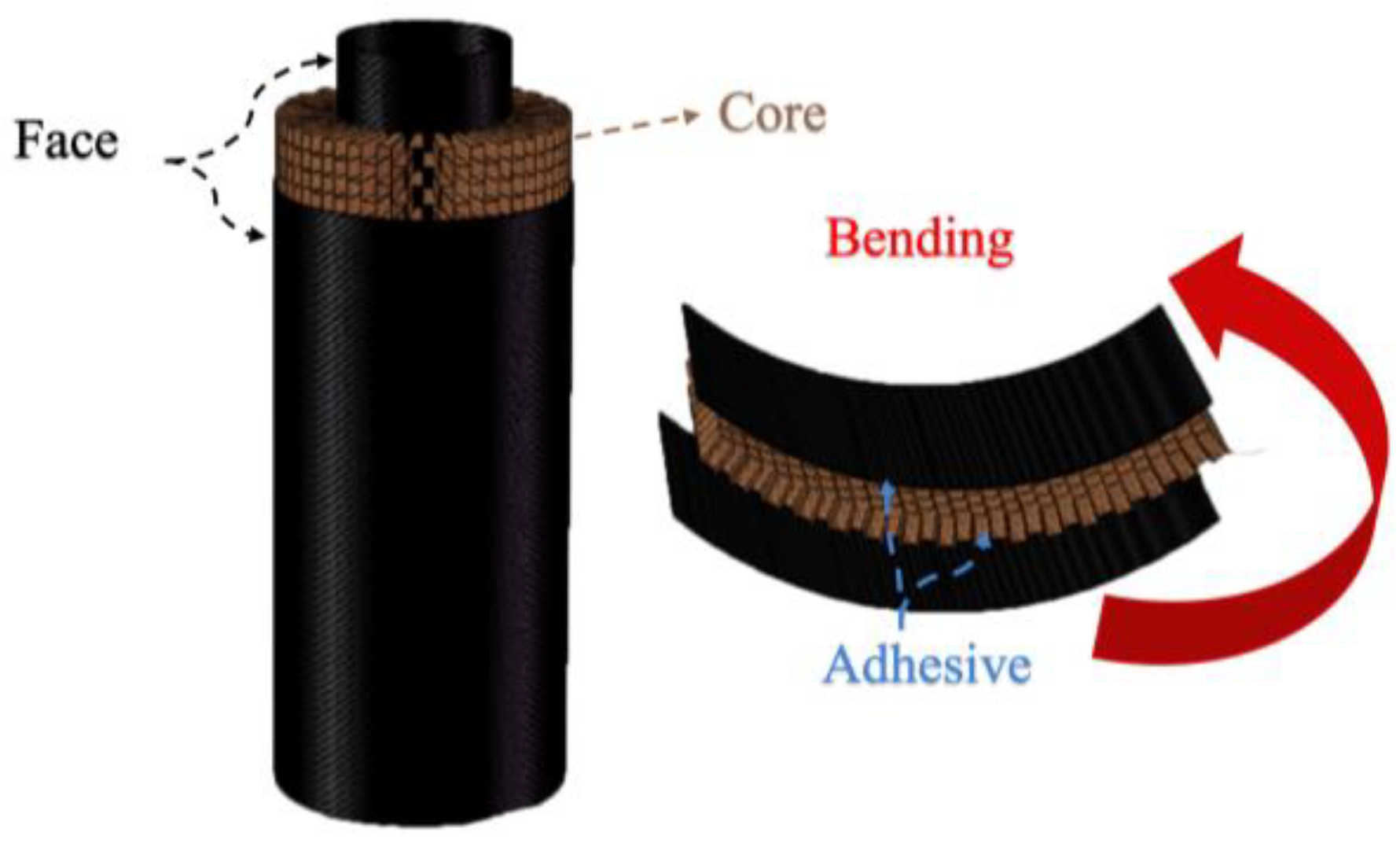

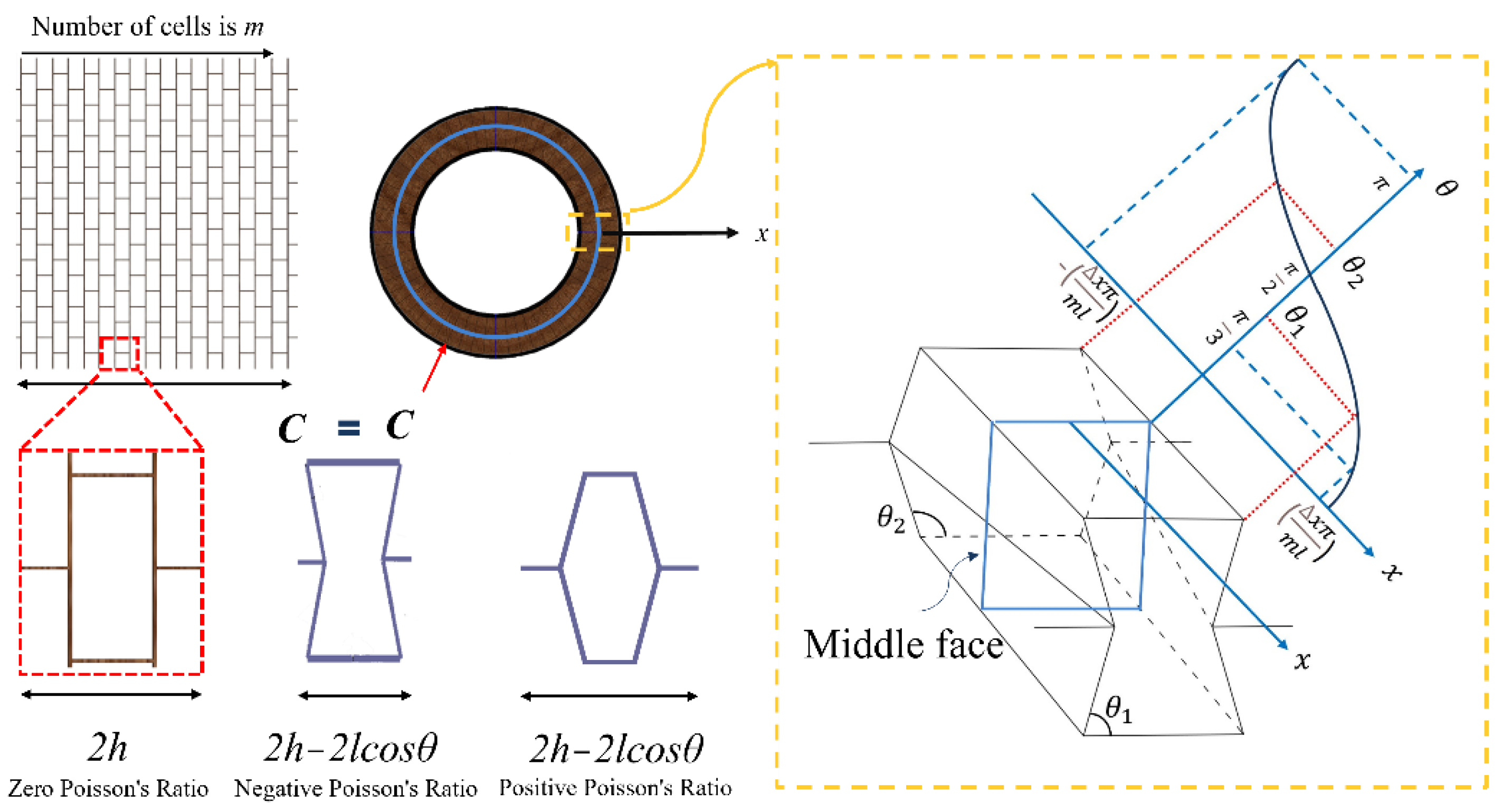

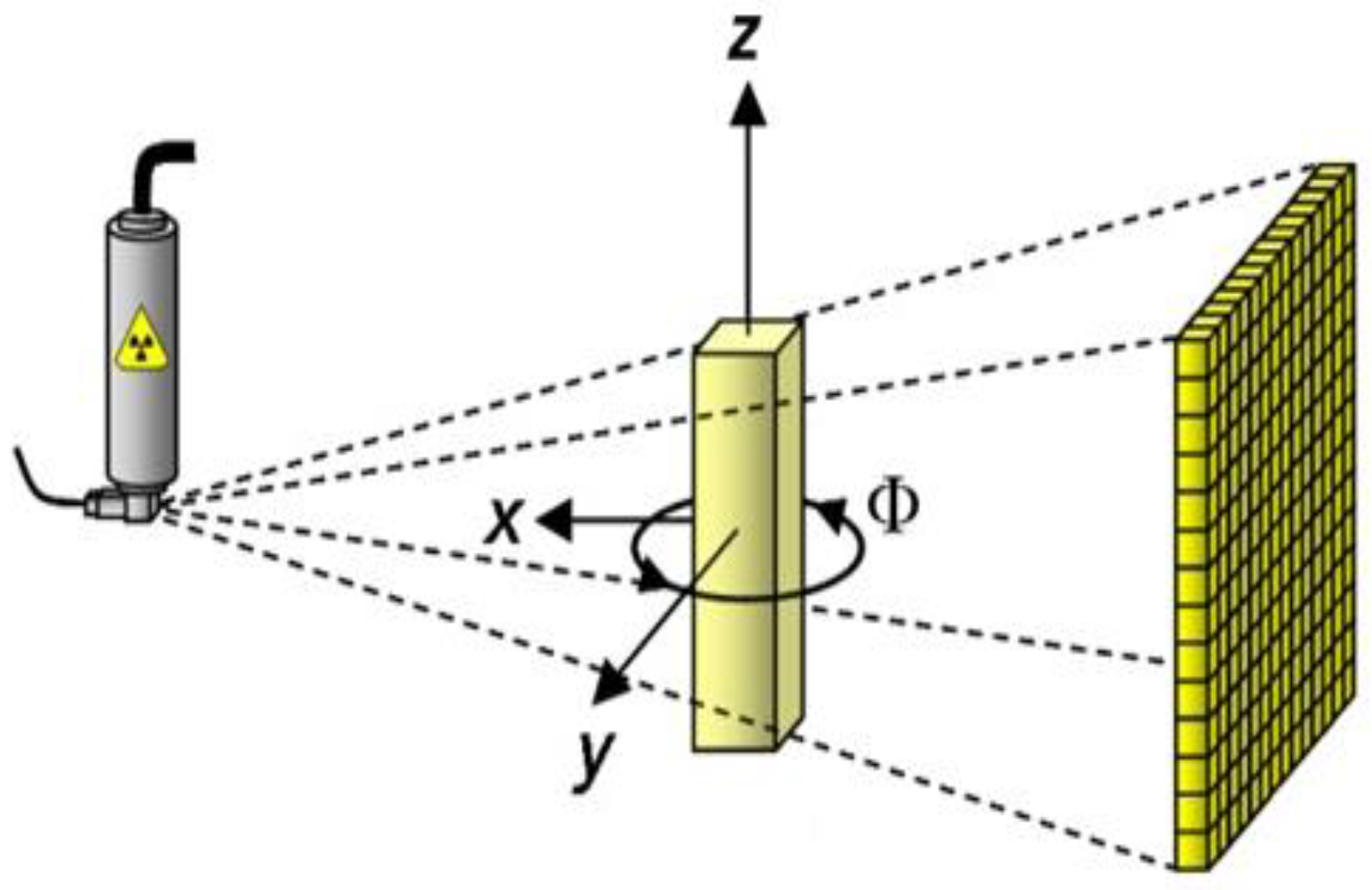



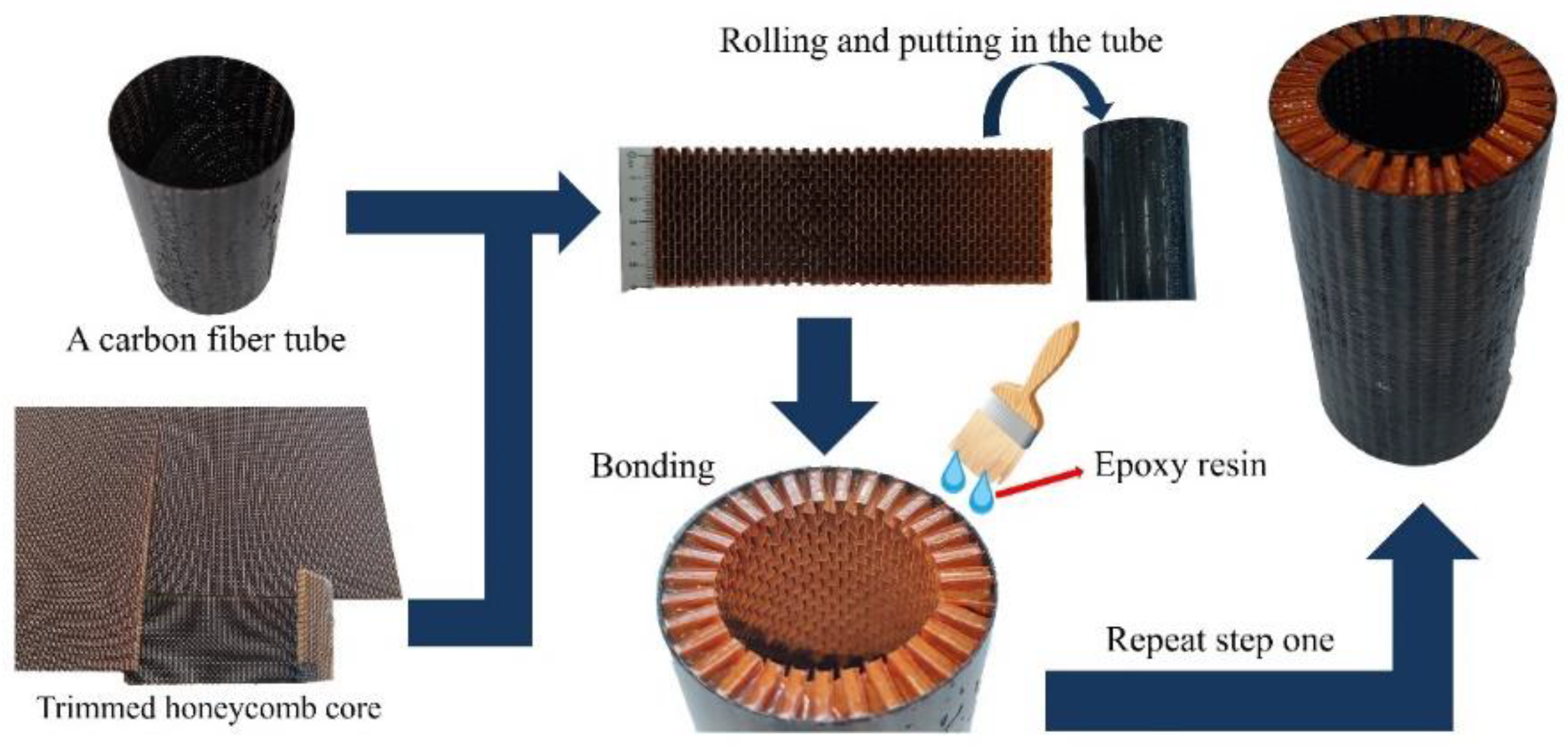
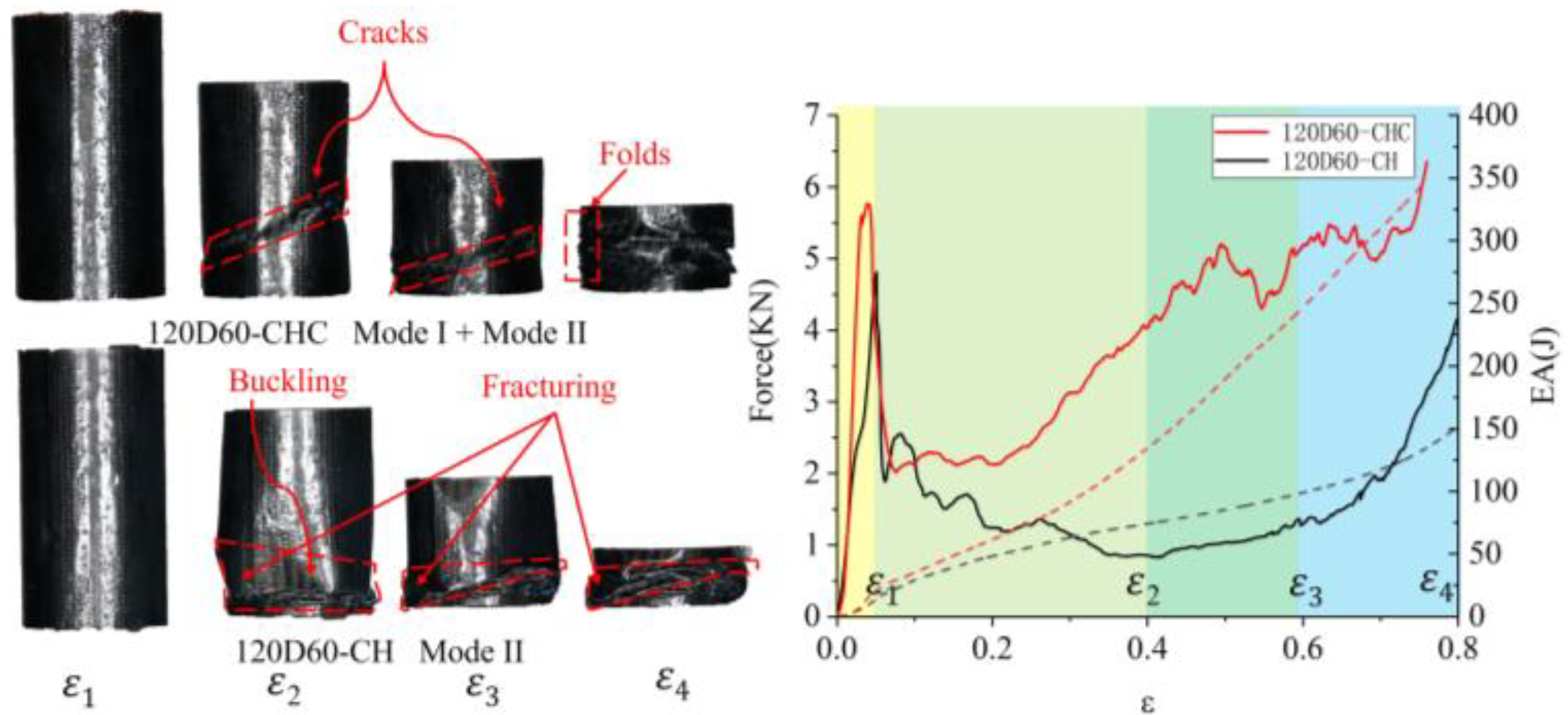

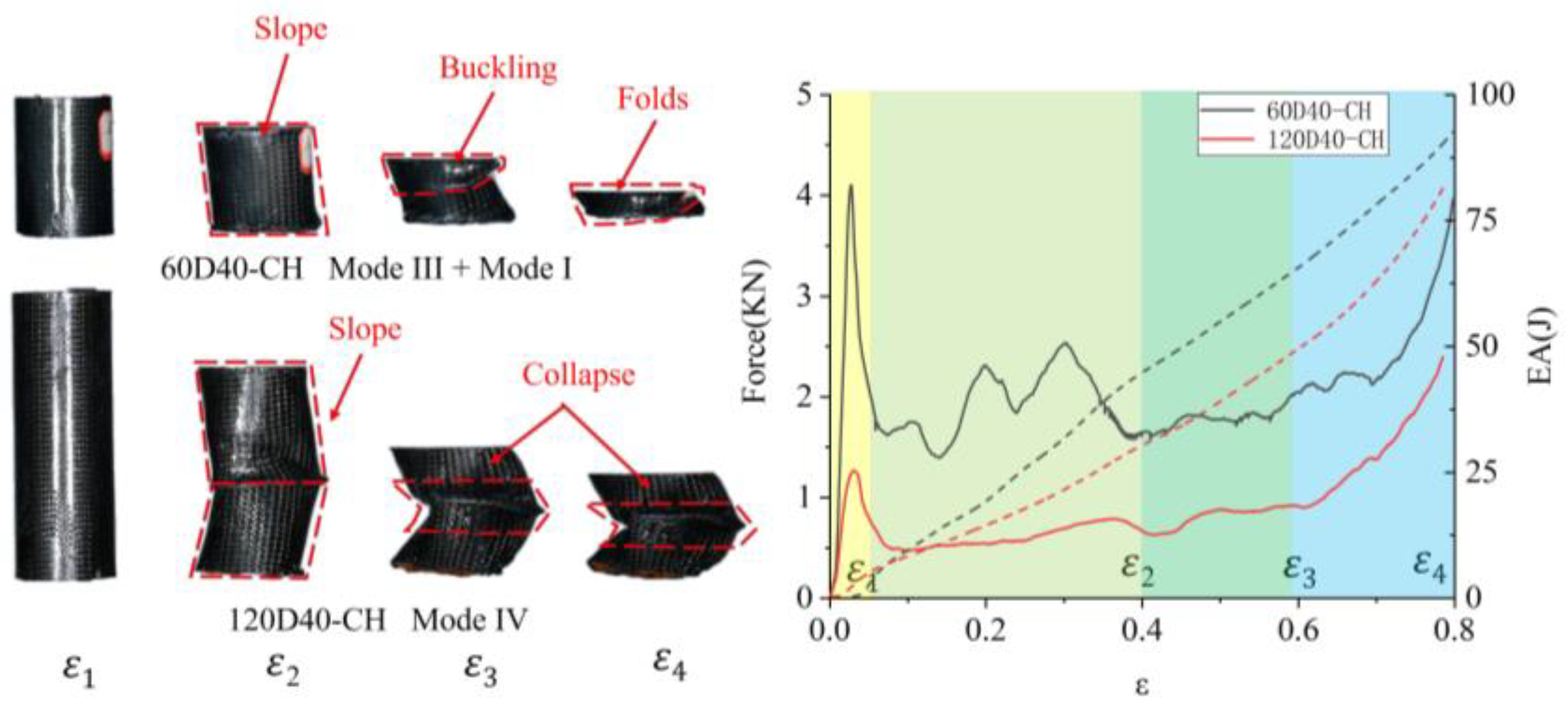
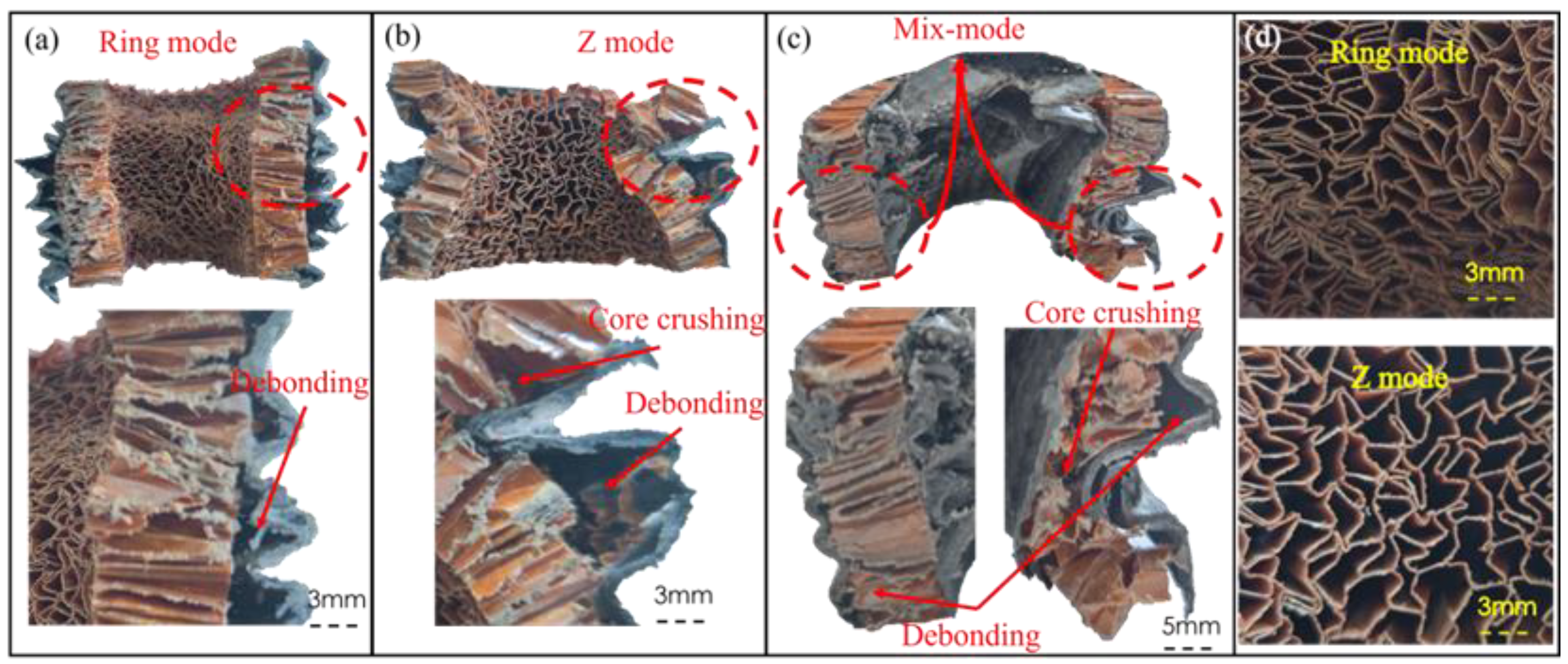
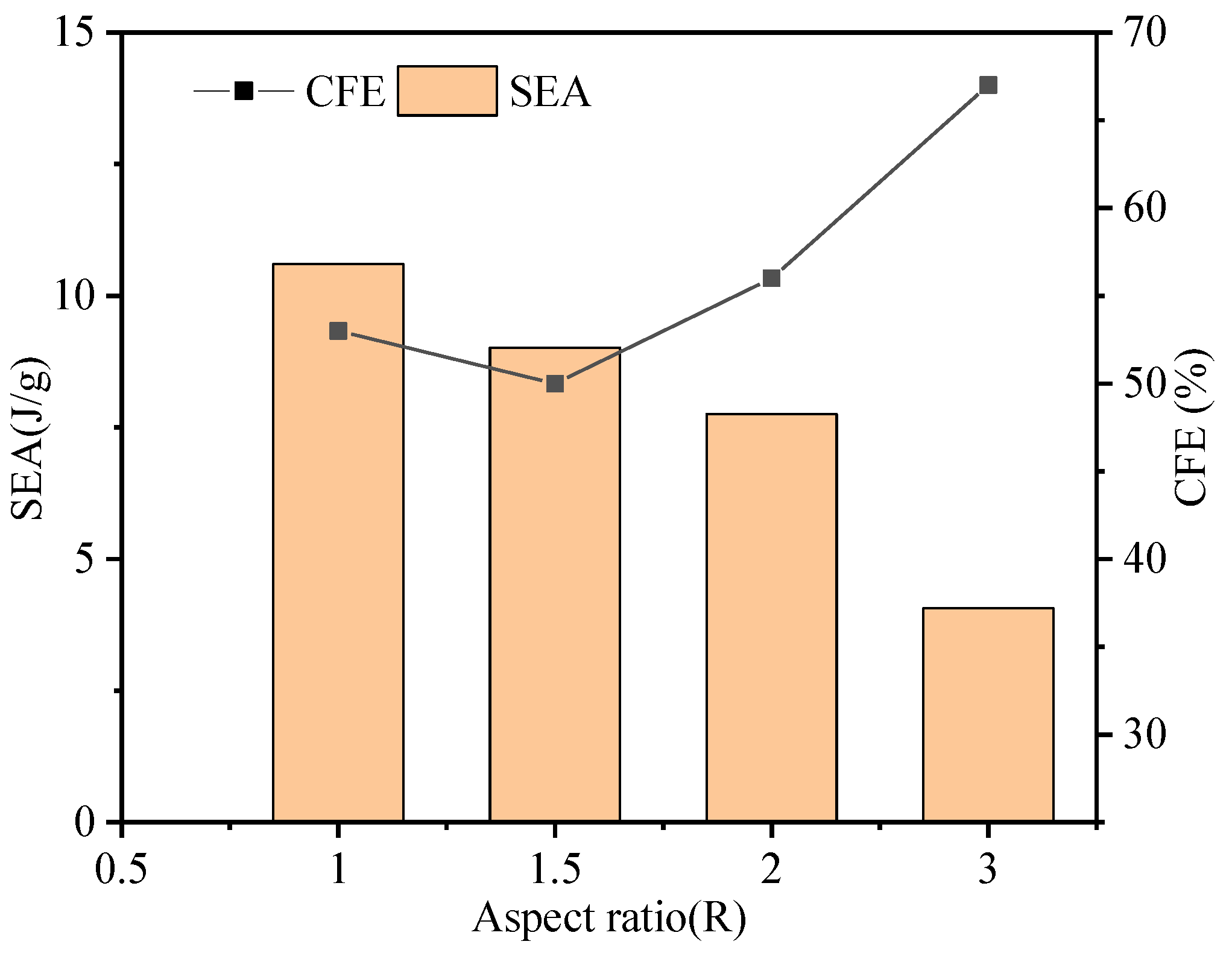
| Material | Material Property | Value |
|---|---|---|
| Epoxy resin | Tension modulus (GPa) | 2.69 |
| Tensile strength (MPa) | 57 | |
| Poisson’s ratio | 0.3 | |
| Density (g/cm3) | 0.93 | |
| Kevlar honeycomb | Even compression strength (MPa) | 2.21 |
| Longitudinal Shear strength (MPa) | 1.28 | |
| Longitudinal Shear modulus (MPa) | 117 | |
| Transverse Shear strength (MPa) | 0.78 | |
| Transverse Shear modulus (MPa) | 35 | |
| Density (g/cm3) | 0.048 |
| H (mm) | b (mm) | D (mm) | d (mm) | W (g) | R | ||
|---|---|---|---|---|---|---|---|
| 60D60-CHC | 60 | 10 | 60 | 40 | 0.5 | 22.5 | 1 |
| 60D60-CH | 60 | 10 | 60 | 40 | 0.5 | 15.8 | 1 |
| 120D60-CH | 120 | 10 | 60 | 40 | 0.5 | 45.0 | 2 |
| 120D60-CHC | 120 | 10 | 60 | 40 | 0.5 | 34.0 | 2 |
| 60D40-CH | 60 | 10 | 40 | 20 | 0.5 | 11.0 | 1.5 |
| 120D40-CH | 120 | 10 | 40 | 20 | 0.5 | 20.0 | 3 |
| PF (kN) | SEA (J/g) | EA (J) | MCF (kN) | CFE (%) | Failure Mode | |
|---|---|---|---|---|---|---|
| 60D60-CHC | 9.4 | 10.6 | 238.56 | 4.97 | 53 | Mode I |
| 60D60-CH | 6.6 | 8.7 | 136.74 | 2.85 | 43 | Mode I + Mode II |
| 120D60-CHC | 6.5 | 7.8 | 348.84 | 3.63 | 56 | Mode I + Mode II |
| 120D60-CH | 4.8 | 4.6 | 158.04 | 1.65 | 34 | Mode II |
| 60D40-CH | 4.1 | 9 | 99.11 | 2.06 | 50 | Mode III + Mode I |
| 120D40-CH | 1.3 | 4.1 | 81.29 | 0.85 | 67 | Mode IV |
Publisher’s Note: MDPI stays neutral with regard to jurisdictional claims in published maps and institutional affiliations. |
© 2022 by the authors. Licensee MDPI, Basel, Switzerland. This article is an open access article distributed under the terms and conditions of the Creative Commons Attribution (CC BY) license (https://creativecommons.org/licenses/by/4.0/).
Share and Cite
Wu, J.; Zhou, J.; Kong, X.; Xu, Y.; Chen, Y.; Zhu, J.; Jin, F.; Wang, P. An Innovative Auxetic Honeycomb Sandwich Tube: Fabrication and Mechanical Properties. Polymers 2022, 14, 4369. https://doi.org/10.3390/polym14204369
Wu J, Zhou J, Kong X, Xu Y, Chen Y, Zhu J, Jin F, Wang P. An Innovative Auxetic Honeycomb Sandwich Tube: Fabrication and Mechanical Properties. Polymers. 2022; 14(20):4369. https://doi.org/10.3390/polym14204369
Chicago/Turabian StyleWu, Jianqin, Jiannan Zhou, Xinli Kong, Ying Xu, Yishun Chen, Juyan Zhu, Fengnian Jin, and Peng Wang. 2022. "An Innovative Auxetic Honeycomb Sandwich Tube: Fabrication and Mechanical Properties" Polymers 14, no. 20: 4369. https://doi.org/10.3390/polym14204369
APA StyleWu, J., Zhou, J., Kong, X., Xu, Y., Chen, Y., Zhu, J., Jin, F., & Wang, P. (2022). An Innovative Auxetic Honeycomb Sandwich Tube: Fabrication and Mechanical Properties. Polymers, 14(20), 4369. https://doi.org/10.3390/polym14204369







